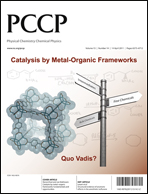Study of host–guest interactions in benzodiazacoronands by means of solid state NMRspectroscopy, X-ray diffraction and quantum mechanical computations†
Abstract
In this work we present solid state data for five host–guest complexes formed by N-(4,19-dioxo-2,8,15,21-tetraoxa-5,18-diazatricyclohexacosa-1(25),9(14),10,12,22(26),23-hexaen-26-yl)-benzamide (1) belonging to the group of benzodiazacoronands, achiral compounds for which chiral crystals were found (J. Kalisiak and J. Jurczak, Cryst. Growth Des., 2006, 6, 20). The X-ray structure was resolved for four of them. It was found that 1 crystallizes in P21/c, P![[1 with combining macron]](https://www.rsc.org/images/entities/char_0031_0304.gif) and P21/n achiral space groups. Differentiation of molecular packing and the presence of guest molecules within the crystal lattice were analyzed with
and P21/n achiral space groups. Differentiation of molecular packing and the presence of guest molecules within the crystal lattice were analyzed with


 Please wait while we load your content...
Please wait while we load your content...